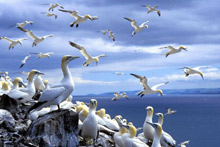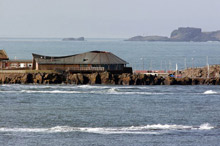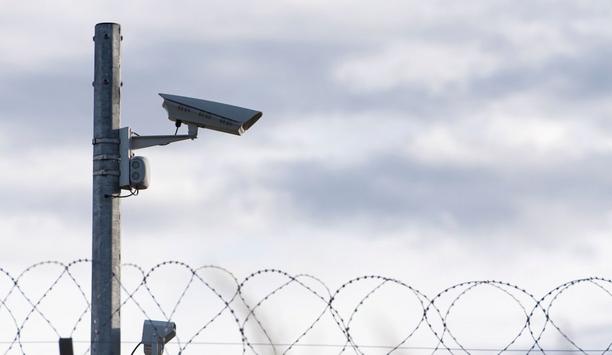 Forward Vision's MIC1 series Pan, Tilt and Zoom (PTZ) CCTV cameras (also known as Metal Mickeys) have helped turn the Scottish Seabird Centre into the world leader in sustainable, remote wildlife watching.
Forward Vision's MIC1 series Pan, Tilt and Zoom (PTZ) CCTV cameras (also known as Metal Mickeys) have helped turn the Scottish Seabird Centre into the world leader in sustainable, remote wildlife watching.
The Scottish Seabird Centre is in an area is internationally renowned for colonies of many seabirds, such as gannets, kittiwakes and puffins. Hundreds of thousands of them come each year to breed on islands such as the Bass Rock and the Isle of May.
Even in reasonable good weather, most of these rocky outcrops are difficult to land on. In the breeding season, people are discouraged from getting too close, partly to avoid disturbing the birds and seals and partly for their own safety: gannets are nearly the size of turkeys, dive at up to 60mph and have beaks that can do a lot of damage. The Seabird Centre's live broadcasting system is definitely the best way to see these magnificent birds at close quarters, without disturbing the animals in any way.
There are now seven Metal Mickeys in strategic locations on four of the islands, as well as two on the mainland. The Plymouth-based wildlife observation specialists, Outersight (UK) Ltd, installed them. According to managing director Peter Barlow, they needed systems that could cope with a very hostile environment.
 "You can get gusts of up to 100mph out there," he says, "and there's a lot of salt spray which is very abrasive and corrosive. You look at other metalwork on the islands and it just rots, but the Mickeys stand up to it very well. I've just had a couple in for servicing. Opened them up and they're as good as new." He had tried other; more traditionally designed cameras but found them useless in the blustery conditions.
"You can get gusts of up to 100mph out there," he says, "and there's a lot of salt spray which is very abrasive and corrosive. You look at other metalwork on the islands and it just rots, but the Mickeys stand up to it very well. I've just had a couple in for servicing. Opened them up and they're as good as new." He had tried other; more traditionally designed cameras but found them useless in the blustery conditions.
"When we found the Mickey and saw how streamlined and compact a unit it was, it just shouts reliability. In fact the first camera we purchased is still fully operational on the site (from the MIC1-300 range). Since then the series has been updated and we are now installing the current MIC1-400 series. There's no exposed cable, it's very neat and the wind resistance is minimal. It's so small and discreet that you hardly know it's there, so it's become a really big part of our business."
Outersight have been working with the Seabird Centre for over seven years, providing the technologies to bring these spectacular wildlife scenes to millions of people at the Centre's virtual hub and to the rest of the world via the internet in a series of live wildlife webcams.
The low-light capabilities of the cameras are well tested, as Peter Barlow explains: "Scotland in the winter has little over three hours of daylight and the rest is dusk or dark so it's imperative that the cameras deliver high quality images regardless of the lighting conditions. That coupled with the integrated wiper and flat viewing window on these cameras means we are able to obtain stunning pictures in bad weather."
The images coming back from the islands and the reliability of the technology have impressed Tom Brock OBE, chief executive of the Scottish Seabird Centre. "Working with Outersight, the Scottish Seabird Centre is at the forefront of this technology. As new technology becomes available, we're able to install the latest cameras," he explains.
 "The images we're now getting are absolutely stunning, broadcast quality. These fantastic compact cameras work reliably throughout the year. They have 360-degree rotation pan and thanks to the design of the cameras, they give us a wider tilt control than others on the market. This gives us great images from remote islands in conditions that are very difficult to manage."
"The images we're now getting are absolutely stunning, broadcast quality. These fantastic compact cameras work reliably throughout the year. They have 360-degree rotation pan and thanks to the design of the cameras, they give us a wider tilt control than others on the market. This gives us great images from remote islands in conditions that are very difficult to manage."
This is all the more impressive because most of the more remote cameras are powered by solar energy. On the Bass Rock and the Island of Craigleith, twelve photo-voltaic solar panels generate enough power, even in a Scottish winter, to keep the cameras and the microwave transmitters running.
Peter Barlow has also been impressed by the quality of service from Forward Vision designers, insisting that they've done everything possible: "...to make sure we get what we want out of the cameras, helping us customise them to meet the demanding conditions."
The success of the systems now means that the Scottish Seabird Centre is recognised as a world leader in the technology of remote wildlife watching, so much so that they're now advising other sites of global interest such as the Falklands and Galapagos Islands.
















